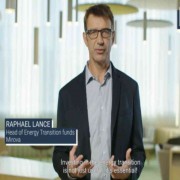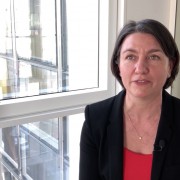Infrastructure Debt
 Mirova: Private Assets Annual Market Review & Outlook
Mirova: Private Assets Annual Market Review & Outlook
Mirova's annual market review and 2024 outlook for private assets.
 Solving the Asian Infrastructure Debt Challenge
Solving the Asian Infrastructure Debt Challenge
Sourcing and risk management are key to executing green projects in the region.
 How to Invest in Energy Transition in Emerging Markets and Improve Lives
How to Invest in Energy Transition in Emerging Markets and Improve Lives
A boutique investor, now part of Mirova, has become a market leader in financing solar power projects in emerging markets.
 Time to Shift for Insurers: Investing in Private Assets (3/3)
Time to Shift for Insurers: Investing in Private Assets (3/3)
In today’s low rate environment, insurers are allocating more and more to private assets.
 Opportunities in Asia-Pacific Infrastructure Private Debt
Opportunities in Asia-Pacific Infrastructure Private Debt
Alistair Ho, Head of Private Debt APAC at Natixis IM Hong Kong, explains what are the main opportunities in the APAC infrastructure private debt market.
 Solving The Private Markets Conundrum for UK DC
Solving The Private Markets Conundrum for UK DC
DC members and smaller DB schemes get long-awaited access to illiquid assets.
 Three Considerations for Insurers Weighing an EM Corporate Debt Allocation
Three Considerations for Insurers Weighing an EM Corporate Debt Allocation
Are insurers making a mistake when it comes to their paltry allocation to emerging market (EM) Corporate Debt? Loomis Sayles thinks so.
 The Case for Core Infrastructure
The Case for Core Infrastructure
Insurers benefit from long-horizon income, low volatility and reduced capital charge.
 Investor Portfolio Alignment with the Paris Agreement: a Multi-Sector, Multi-Asset Class Approach
Investor Portfolio Alignment with the Paris Agreement: a Multi-Sector, Multi-Asset Class Approach
S&P Trucost and Natixis IM Solutions detail the extension of the 2°C alignment assessment methodology to private and illiquid asset classes in order to obtain consistent multi-sector, multi-asset class analyses.
 Real Asset Debt: Crisis Expands Opportunity for Tailor-made Mandates
Real Asset Debt: Crisis Expands Opportunity for Tailor-made Mandates
Consistent cashflows, even in periods of high volatility, enable investors to match long-term needs.
 Infrastructure: the Rise of an Asset Class
Infrastructure: the Rise of an Asset Class
In a Q&A, Gwenola Chambon, chief executive of Vauban Infrastructure Partners, explains how infrastructure became a portfolio staple.
 Financing the Necessary Ecological Transition of Transport
Financing the Necessary Ecological Transition of Transport
The energy, industry, buildings and transport sectors together currently account for three quarters of global greenhouse gas emissions, with mobility alone representing no less than 24% of CO2 emissions caused by energy combustion.
 Investing in Infrastructures to Accelerate Energy Transition
Investing in Infrastructures to Accelerate Energy Transition
Essential, profitable, tangible, mature: all these features explain the growing interest of institutional investors in green infrastructures.
 Renewable Energy Investments Demonstrate Resilience
Renewable Energy Investments Demonstrate Resilience
Resilience is enhanced with infrastructure debt instruments.
 “The Green Sector has been Less Affected than Other Infrastructure”, says Mirova
“The Green Sector has been Less Affected than Other Infrastructure”, says Mirova
In this Clear Path Analysis report, Mirova expert elaborates on how the pandemic crisis may energise infrastructure and where are the opportunities in next generation energy infrastructure.
 Opportunities in Next-Generation Energy Infrastructure
Opportunities in Next-Generation Energy Infrastructure
Investment opportunities in the energy transition are no longer limited to the mature solar and wind segments.
 Covid-19 Has Redefined Infrastructure Needs: Implications for the Municipal Bond Market
Covid-19 Has Redefined Infrastructure Needs: Implications for the Municipal Bond Market
Municipal system administrators and investors are reassessing whether the long-term prospects for many critical sectors of the economy have changed irreparably
 COVID-19: Impact on Renewables
COVID-19: Impact on Renewables
Ostrum Private Debt Real Asset team looks into the impacts of the COVID-19 crisis on the renewable sector.
 What Growth Are We Seeing in Private Debt and Real Assets?
What Growth Are We Seeing in Private Debt and Real Assets?
Clear Path Analysis sits down with Denis Prouteau, CIO of Private Debt & Real Assets at Ostrum AM, to talk about the prospects of real assets, infrastructure and private debt going forward.
 Asia-Pacific Infrastructure: Building the Opportunity
Asia-Pacific Infrastructure: Building the Opportunity
Charlse Regan, Head of Asia-Pacific Infrastructure Debt Ostrum AM Hong Kong, discusses the top 10 reasons to consider Infrastructure Debt as a portfolio diversifier.
 Infrastructure Debt: Where is the Value for Investors?
Infrastructure Debt: Where is the Value for Investors?
2018 has been a very positive year for volumes in infrastructure debt with conventional and renewable energy reaching peak volume and the appearance of new high-potential territories.
 The Five Myths of “Illiquids”
The Five Myths of “Illiquids”
How UK Defined Contribution (“DC”) schemes can overcome the misconceptions that stop them offering investments with superior risk-return potential.
 Secure Income and Green Infrastructure: An Unlikely Marriage?
Secure Income and Green Infrastructure: An Unlikely Marriage?
How to source stable, long-term cashflows from infrastructure debt with a strong ESG focus
 Investing in Infrastructure Private Debt with an ESG Lens
Investing in Infrastructure Private Debt with an ESG Lens
Céline Tercier, Head of Infrastructure Private Debt at Ostrum Asset Management, explains why financing infrastructure through private debt with an ESG lens contributes to energy transition.
 Real Assets: Invest In What You Want, How You Want
Real Assets: Invest In What You Want, How You Want
Creating bespoke portfolios through alignment of bank and asset management capabilities
 Infrastructure Debt Market Insight
Infrastructure Debt Market Insight
NAM Newsletter
 Real Asset Debt: A Substitute for Bonds?
Real Asset Debt: A Substitute for Bonds?
Collateralised assets benefit insurers under Solvency II.
 Solvency 2: Rethinking the Debt Portfolio
Solvency 2: Rethinking the Debt Portfolio
How to incorporate SCR constraints into the portfolio allocation for insurer.
 It's Time for Real Assets
It's Time for Real Assets
Private debt can be a lower-risk, higher-yielding alternative to traditional bonds.
 Real Estate, Infrastructure, Aircraft
Real Estate, Infrastructure, Aircraft
Institutional investors are increasingly attracted by real asset private debt.
 Alternative Strategies May Add Value to Institutional Portfolios
Alternative Strategies May Add Value to Institutional Portfolios
Including alternatives strategies in a portfolio can help to improve performance whilst reducing risk.




